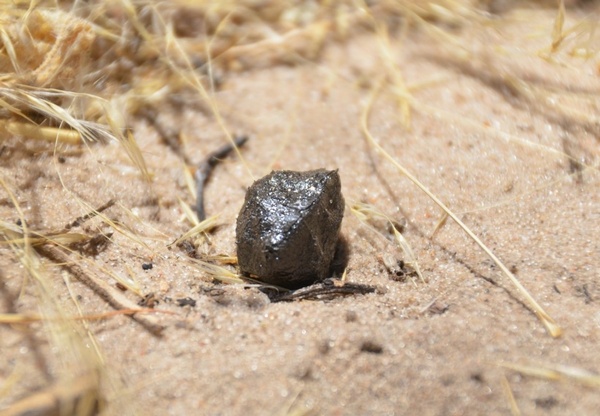Thanks to the isotopes in those fragments, researchers determined that 2018 LA, called such by the University of Arizona's Catalina Sky Survey as part of NASA's Planetary Defense program, was a solid rock about 1.5 m in size, which reflected about 25 percent of sunlight.
Eight hours later, a video camera in South Africa recorded a bright fireball over Botswana and the hunt was on for surviving meteorites deep inside the Central Kalahari Game Reserve. The first meteorite they found 18 grams and about 3 cm in size.
A recent analysis shows what scholars call the Motopi Pan asteroid belonged to the group of Howardite-Eucrite-Diogenites (HED) meteorites, known to have likely originated from the giant asteroid Vesta, which was recently studied in detail by NASA’s DAWN mission.

Fragment of asteroid 2018 LA recovered in Central Kalahari Game Reserve in central Botswana. Photo: Peter Jenniskens/SETI Institute
"We managed to measure metal content as well as secure a reflectance spectrum and X-ray elemental analysis from a thinly crusted part of the exposed meteorite interior," said Tomas Kohout of the University of Helsinki. "All the measurements added well together and pointed to values typical for HED type meteorites."
Dynamical studies show that the orbit of 2018 LA is consistent with an origin from the inner part of the asteroid belt where Vesta is located. The asteroid was delivered into an Earth-impacting orbit via the resonance situated in the asteroid belt's inner side.Other studies also confirmed the surprising diversity of the team’s finds, such as reflection spectroscopy and the content of polyaromatic hydrocarbons in the sample. The asteroid was a breccia, a mixture of cemented rock pieces from different parts on Vesta.
When Jenniskens returned to Botswana in October of 2018, the team found 22 more small meteorites. Subsequent meteorite finds showed a lot of diversity in their outward appearance.
A previous hypothesis proposed that Sariçiçek originated from Vesta in the collision that created the Antonia impact crater imaged by DAWN. Still showing a visible ejecta blanket, that young crater was formed about 22 million years ago. One-third of all HED meteorites that fall on Earth were ejected 22 million years ago. Did Motopi Pan originate from the same crater?
Noble gas isotopes measurements showed that this meteorite had been in space as a small object for about 23 million years. Phosphate grains in Motopi Pan experienced another melting event more recently. Vesta experienced two significant impact events that created the Rheasilvia impact basin and the underlying, and therefore older, Veneneia impact basin.
"We now suspect that Motopi Pan was heated by the Veneneia impact, while the subsequent Rheasilvia impact scattered this material around," said Jenniskens. "On top of Rheasilvia impact ejecta is the 10.3-km diameter Rubria impact crater, slightly smaller than the 16.7-km Antonia crater, and slightly younger at 19 +/- 3 million years, but a good candidate for the origin crater of Motopi Pan."





Comments